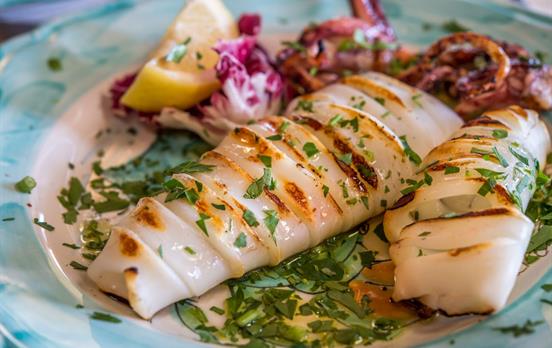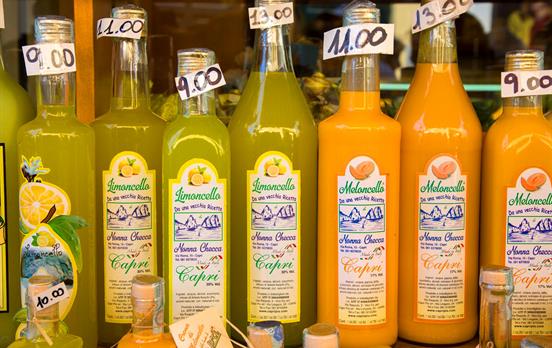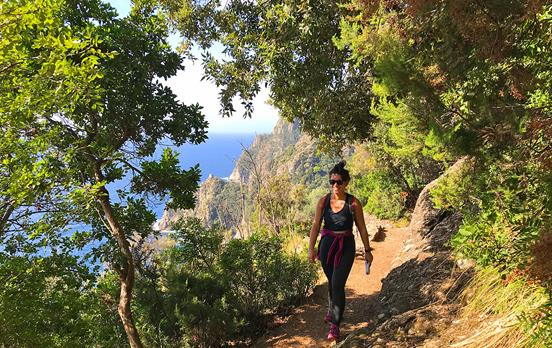Cinque Terre. The Five Lands. You’ve probably heard of this magical-sounding place, and you've almost certainly seen photographs of the rainbow-like villages clinging to the rugged Italian coastline. Now, you're ready to lace up your hiking boots and explore this spectacular part of the Italian Riviera. Welcome to your ultimate guide to hiking Cinque Terre!

The Five Villages of Cinque Terre (Plus Two Bonuses!)
Monterosso al Mare
Monterosso al Mare is the largest of the five villages and the only one with a sandy beach and a car park. This often makes it the most crowded, but don't worry—you can escape into the labyrinthine old town, historically walled for protection from pirate sea raids.
Vernazza
Vernazza, first mentioned in 1080 AD, epitomizes the quintessential Cinque Terre charm. Totally car-free and cradled by steep mountain slopes, Vernazza boasts a natural port. Brave the crashing waves to reach the end of the marina arm and enjoy a mesmerizing viewpoint.
Corniglia
Corniglia is unique, perched like a bird's nest atop a rocky spur 328 feet above sea level. The smallest village in Cinque Terre, with just 150 residents, it lacks a port and more closely resembles hinterland architecture. From here, you can see all five villages—a sight that's truly hard to beat.
Manarola
Manarola scales the steep mountainside much like its terraced vineyards. Its tiny harbor means fishing boats must be pulled onto land whenever rough seas threaten. Famous for its wine for millennia, even writers of ancient Roman couldn't resist mentioning it!
Riomaggiore
Riomaggiore dates back to the 8th century. Its earliest inhabitants were winemakers who fled from Greece during the Byzantine Empire. The village's colorful houses cascade down to the sea, creating a picturesque setting that’s perfect for a leisurely hike.
Bonus Villages - Portofino and Porto Venere
Don't miss out on these two gems! Portofino, to the northwest, has attracted the rich and famous since the 1950s. Porto Venere, to the southeast, is a medieval fishing village with must-see landmarks like the Church of San Pietro and Castle Doria. Both villages are perfect additions to your Cinque Terre adventure.

Best Time of Year to Visit Cinque Terre
Cinque Terre enjoys a Mediterranean climate, making it accessible nearly all year round. The best months to visit are March to October, although July and August can be hot and busy. Always be prepared to take on some ascents in the heat if you’re hiking in the peak summer months and remember that the sea temperature increases throughout the year, perfect for those who love a good swim.
Best Hikes in Cinque Terre
Get ready for an unforgettable journey where you can explore the stunning landscapes of Portofino and the Cinque Terre! This hiking trip offers the perfect blend of sensational scenery and the chance to immerse yourself in the rich culture of this beautiful region. Picture yourself wandering sun-drenched trails lined with vibrant wildflowers, as the azure sea sparkles below you. Each step brings you closer to quaint villages, where you can pause to enjoy local delicacies and chat with friendly locals. Whether you’re an experienced hiker or just looking to enjoy a leisurely walk, these self-guided trips are designed to empower you to connect with nature and create lasting memories. So, lace up your hiking boots, grab your backpack, and take on an adventure that will leave you feeling invigorated and inspired!
For more epic hikes in Italy, check out our Best Hiking Vacations in Italy blog post.
How Long is the Hiking Trail? How Much Time Do I Need?
Considering the steep and winding paths, it's best to take your time. Plan for a week-long Cinque Terre trip that spans 37 miles from Camogli to Portovenere to truly immerse yourself in the landscape and the culture. But if you’re short on time, we also offer a Cinque Terre short break. It covers 16 miles and nicely packages the route along the five villages up into five days.
How to Get to Cinque Terre
The closest large cities are Genoa and Pisa. All five villages are accessible by train, although express trains skip all but Monterosso al Mare and La Spezia. From there, slower trains connect to each village.
For more detailed travel logistics and tips, read our Traveling to and around Italy article.
What to Pack for a Hiking Trip in Cinque Terre
Pack sturdy, comfortable hiking boots, hiking poles for uneven terrain, sunscreen, a hat, and plenty of water (about 25 fluid ounces per hour of hiking). Don’t forget swimming clothes and a towel if you plan to take a dip (which we think is an absolute must!).
For a breakdown of what to pack, see our What to Pack for a Self-Guided Hiking Adventure blog post.

Things to Do in Cinque Terre
Aside from hiking, there are countless activities to enjoy:
- Beach Time: Relax on the sandy beach of Monterosso al Mare, where you can soak up the sun, enjoy the gentle waves, and indulge in local beachside snacks. The beach offers amenities like sunbeds and umbrellas for a comfy day by the sea.
- Wine Tasting: Sample exquisite local wines in Manarola and surrounding areas, known for their picturesque vineyards. Join guided tours that provide insights into the winemaking process and savor the unique flavors of the region’s celebrated white wines, like Sciacchetrà.
- Historical Sites: Explore the rich history of the region by visiting stunning churches, medieval castles, and ancient ruins. Notable sites include the Church of San Giovanni Battista in Monterosso and the remnants of the Doria Castle in Manarola, each telling a story of the past.
- Boat Tours: Experience the dramatic coastline and colorful villages from a different perspective on a boat tour. Choose from options like sunset cruises or day trips that allow you to swim in secluded coves and take in panoramic views of the cliffs and sea.
What to Eat and Drink in Cinque Terre
Cinque Terre is a food lover's paradise. Taste Monterosso anchovies, savor local honey gelato in Corniglia, and indulge in regional specialties like pesto, seafood, and DOC-quality wines. This certificate is granted to Italian wines that exhibit distinctive qualities of superior excellence, which are determined by the type of grape, the production region, and the techniques used in processing and aging.
For detailed foodie insights and first recommendations from one of our Adventure experts, read our Where to Eat in Portofino and Cinque Terre blog post.
Italy Travel Tips
When traveling to Italy, keep these tips in mind:
- Language: Learn basic Italian phrases.
- Currency: Euros are the currency here.
- Etiquette: Dress modestly when visiting churches and religious sites.
For more tips, check out our Italy Travel Tips blog post.
Cinque Terre vs. Amalfi Coast
If you're torn between Cinque Terre and the Amalfi Coast, you're not alone. Each destination has its own unique charm.
To help you decide, read our Cinque Terre vs. Amalfi Coast blog post.
Whether you're an adventure traveler, a nature enthusiast, or a member of the hiking community, Cinque Terre offers an unparalleled experience. From its picturesque villages to its challenging trails, this region promises unforgettable memories. Ready to start your Cinque Terre adventure? Book a call with one of our adventure specialists today and let's make it happen!

To discover more about our self-guided Italy hiking trips, head to our Guide to Hiking in Italy for tips, advice and inspiration.





















 Canada
Canada